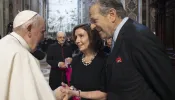By Brian Pizzalato
In previous columns, I have shown how certain truths of the faith in the New Testament were prefigured and foreshadowed in the Old Testament. Here, I will focus on the Eucharist.
There are a number of ways in which God has foreshadowed the work of Christ in the Eucharist. He has done so through the various signs of bread and wine in the Old Testament, Abram’s interaction with Melchizedek, the Passover, and the manna and quail the Israelites ate in the desert.
First, there is Abram (later to be called Abraham) and his encounter with Melchizedek, king of
Second, we have the Passover, the most significant event for the people of the Old Testament. For a full account of the Passover ritual, read Exodus 12. Here are some highlights that relate to the Eucharist.
We note that a lamb without blemish must be sacrificed according to how much each man could eat. We know from the lips of John the Baptist that Jesus is, “…the Lamb of God, who takes away the sin of the world” (John 1:29). We also know Jesus is the lamb without blemish. Pilate proclaimed, “I find no guilt in him” (John 18:38). It is also the case that we must eat the lamb. “…Unless you eat the flesh of the Son of Man and drink his blood, you do not have life within you” (John 6:53). The whole assembly was to gather together to sacrifice the lambs. We too are called to assemble for the sacrifice of the Eucharist, the new Passover celebration. Then they were to take the blood of the lamb and put it on the lintels and doorposts where they were going to eat the lamb with unleavened bread. The blood was to be a sign of deliverance of the first born sons of
We are called to receive the blood of Christ, the only begotten son of the Father, and eat the Bread of Life as a sign of our deliverance from slavery to sin. Exodus goes on to say, “This day shall be a memorial feast for you, which all your generations shall celebrate with pilgrimage to the Lord, as a perpetual institution” (Exodus 12:14). They are also required to keep a feast of unleavened bread, “as perpetual institution” (Exodus 12:17). In the Eucharist, all these elements are combined to make up Mass as our keeping of the memorial feast of Christ: “Do this in memory of me” (Luke 22:19). It might also be noted that after God prescribes for them what to do, “the people bowed their head and worshipped” (Exodus 12:27). The eucharistic sacrifice is where we are called to worship the Lamb of God, in spirit and truth. Another crucial point is that the Eucharist was instituted during the feast of the Passover.
Third, we have God supplying manna and quail for the Israelites in the desert. While the people are in the desert after the Exodus, they murmur against God, accusing him of murderous plans by means of starvation. God responds, “I will rain down bread from heaven for you. Each day the people are to go out and gather their daily portion…” (Exodus 16:4) During the feast of Passover, the year before the Eucharist was instituted at the Last Supper, Jesus says, “…it was not Moses who gave the bread from heaven; my Father gives you the true bread from heaven…I am the bread of life…” (John 6: 32, 35). It is no coincidence that “the Jews murmured about him” just as they did in Moses’ day (John 6:41). Many Catholics in our day murmur about this as well. In the morning God will give the bread to eat, and “the Lord gives you flesh to eat in the evening” (Exodus 16:8). In the Eucharist, we know that the bread becomes Jesus’ flesh for the life of the world (cf. John 6:33). The Israelites were to eat the flesh, and be filled with bread. In receiving the Eucharist, we, too, must believe Jesus’ words, “Whoever comes to me will never hunger” (John 6:35).
If it was not clear before, it should be clear now, that our Father knows how to teach his children. In our study of the faith, we can never, ever do away with the Old Testament. In studying the New Testament we must remember the words of the catechism, “...the books of the Old Testament bear witness to the whole divine pedagogy of God’s saving love…‘in them, too, the mystery of our salvation is present in a hidden way’” (CCC 122).
Printed with permission from the Northern Cross, Diocese of Duluth, Minnesota.
Brian Pizzalato is the Director of Catechesis, R.C.I.A. & Lay Apostolate for the Diocese of
Brian holds an M.A. in Theology and Christian Ministry with a Catechetics specialization and an M.A. in Philosophy from Franciscan University of Steubenville,











